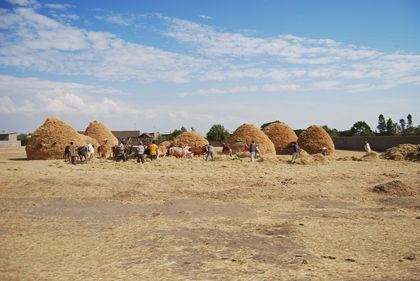Ethiopia - Poverty and wealth

Under the rule of Haile Selassie, Ethiopian society was characterized by gross inequality between the largely aristocratic elite—consisting of landowners, lords, nobles, the royal family, government officials, and elements of the clergy—and the impoverished peasantry. Indeed, according to Kebbede, the massive famines of the 1960s could have been avoided if the obligations on the part of the peasantry towards the elite (in terms of providing agricultural produce) had not been so oppressive. The Derg regime subsequently abolished feudal obligations and titles of privilege, even going to the extreme of executing numerous members of the high-ranking nobility (the socalled "red terror"). Despite the egalitarian rhetoric of the Derg, however, high-ranking government officials
| GDP per Capita (US$) | |||||
| Country | 1975 | 1980 | 1985 | 1990 | 1998 |
| Ethiopia | N/A | N/A | 91 | 100 | 110 |
| United States | 19,364 | 21,529 | 23,200 | 25,363 | 29,683 |
| Dem. Rep. of Congo | 392 | 313 | 293 | 247 | 127 |
| Eritrea | N/A | N/A | N/A | N/A | 175 |
| SOURCE: United Nations. Human Development Report 2000; Trends in human development and per capita income. | |||||
retained privileged economic positions. Today, Ethiopia's elite continues to consist of government officials, in addition to a small upper class of highly skilled managers and professionals.
Like all the countries of Sub-Saharan Africa, poverty is rampant in Ethiopia. The UNDP's Human Development Index (HDI) listings, which arranges countries according to their overall level of human development, ranks Ethiopia 171st out of a total of 174 nations. The HDI is a composite index (one that assesses more than one variable) that measures life expectance at birth, adult literacy rate, school enrollment ratio, and the GDP per capita . It is indicative of a country's general social and economic well-being. As such, Ethiopia's HDI ranking demonstrates that the country is one of the poorest and least developed in the world. Fortunately, the situation has shown small signs of improvement, and the Ethiopian HDI score increased from a dismal 0.265 in 1985 to a slightly better 0.309 in 1998 (the highest possible rank is 1.0, and Canada—the highest ranking HDI country— scored 0.935 in 1998).
The Ethiopian government spends relatively little on education and health. In 1998, for example, public expenditure on health and education as percentages of the GDP equaled 1.6 percent and 4.0 percent respectively. Though these expenditures displayed marginal increases,
| Distribution of Income or Consumption by Percentage Share: Ethiopia | |
| Lowest 10% | 3.0 |
| Lowest 20% | 7.1 |
| Second 20% | 10.9 |
| Third 20% | 14.5 |
| Fourth 20% | 19.8 |
| Highest 20% | 47.7 |
| Highest 10% | 33.7 |
| Survey year: 1995 | |
| Note: This information refers to expenditure shares by percentiles of the population and is ranked by per capita expenditure. | |
| SOURCE: 2000 World Development Indicators [CD-ROM]. | |
they are nowhere near the percentage level of industrialized countries, such as the United States, which spent 5.4 percent of the GDP on education and 6.5 percent on health in 1998. Moreover, the Ethiopian government spends a significant amount on military expenditure, largely as a result of the border war with Eritrea, though such expenses have decreased substantially from 10.4 percent of the GDP in 1990 to 3.8 percent in 1998. The fact that the Ethiopian government must continually service a large debt does not help the social expenditure cause.
The vast majority of Ethiopians spend their meager incomes on the basic necessities of life, such as food, rents, clothing, fuel, and transportation. Very little is spent on entertainment and recreation, which are considered luxuries for those that live in considerable poverty. To make matters worse, in the past 10 years, the increase in the GNP per capita has been grossly outweighed by mounting inflation, which means that Ethiopians are having an increasingly difficult time purchasing the commodities essential for human existence. The UNDP estimates that the annual growth rate in GNP per capita between 1990 to 1998 was 1.0 percent, while the average annual rate of inflation during the same period was 9.7 percent.
Comment about this article, ask questions, or add new information about this topic: